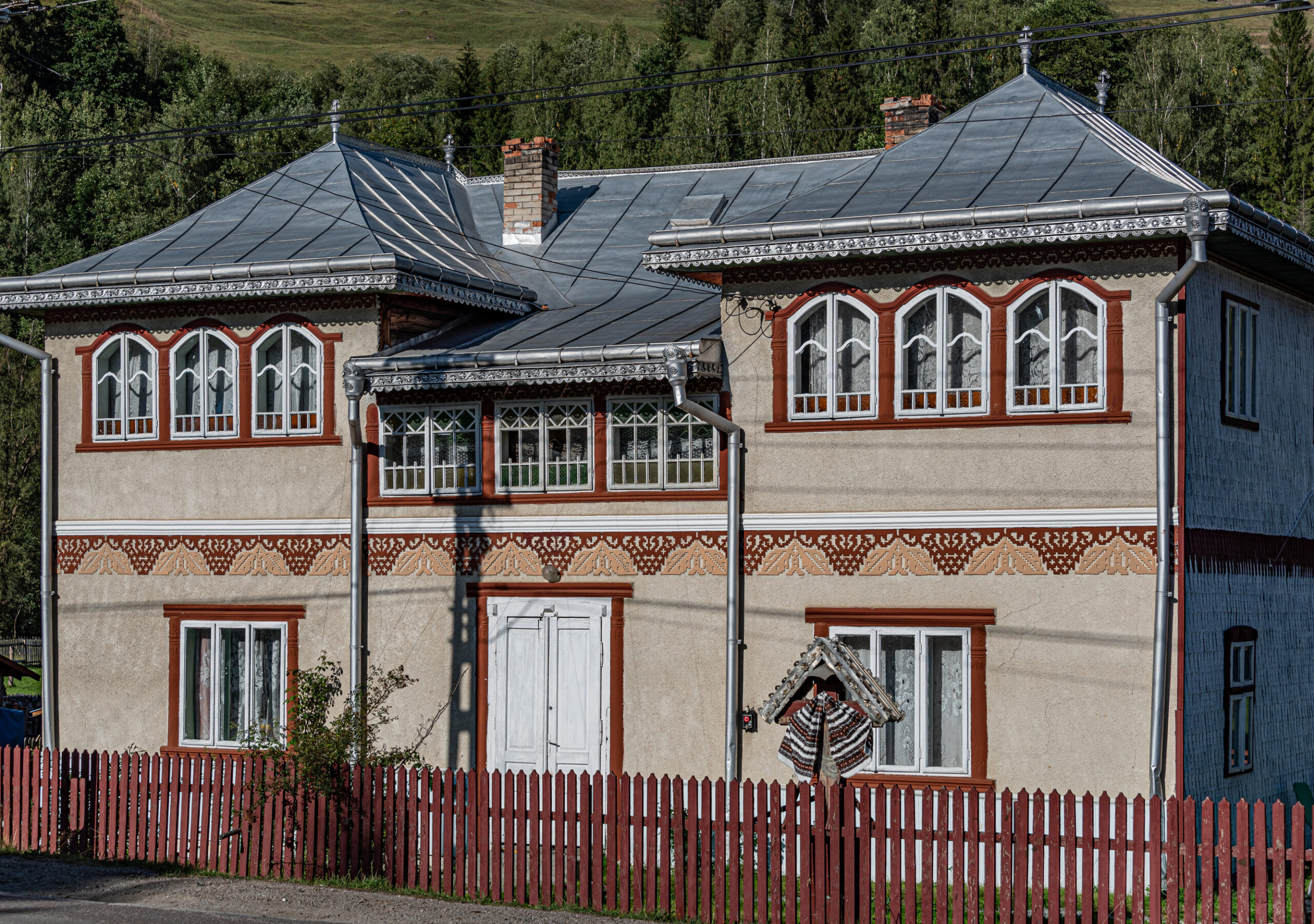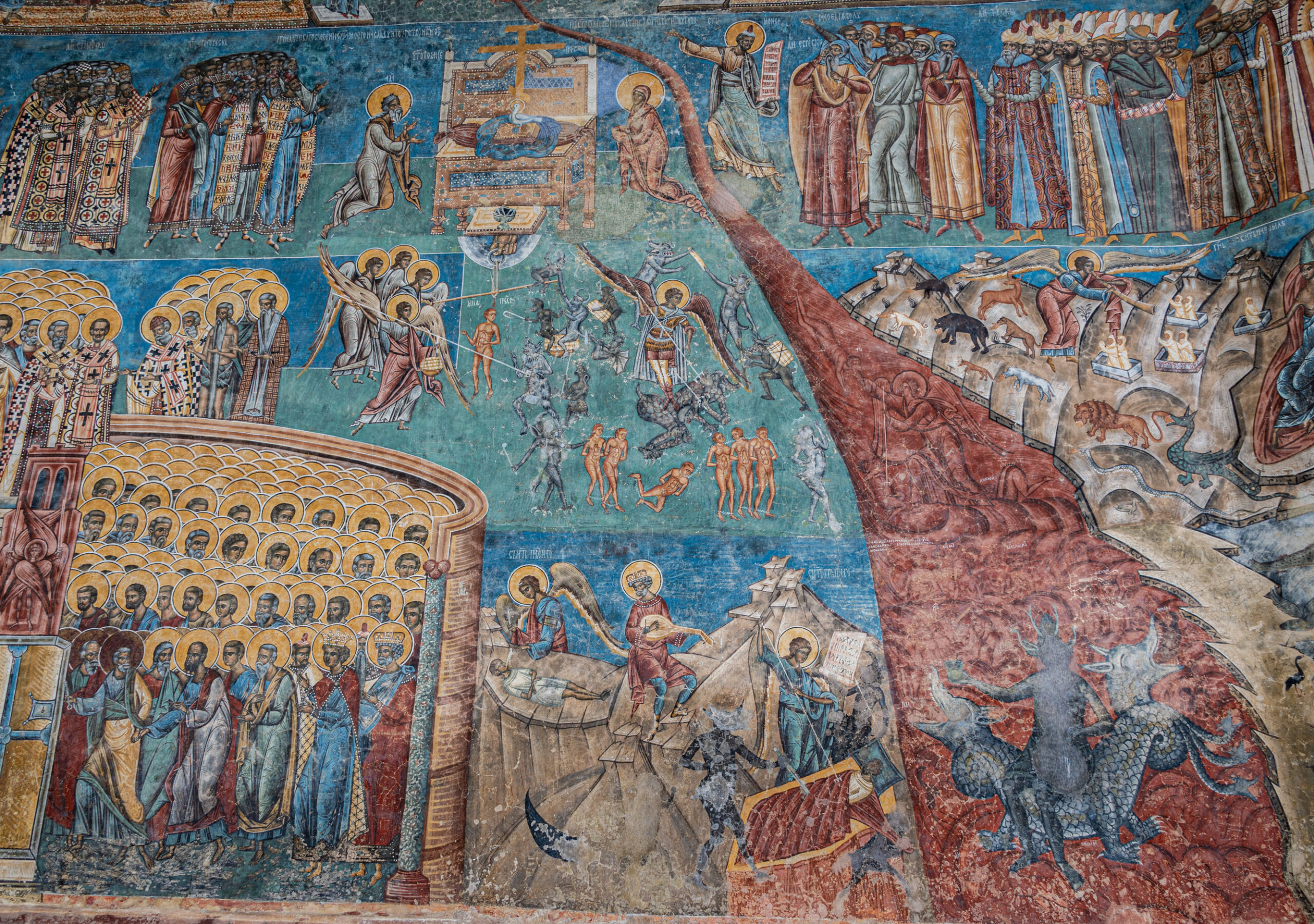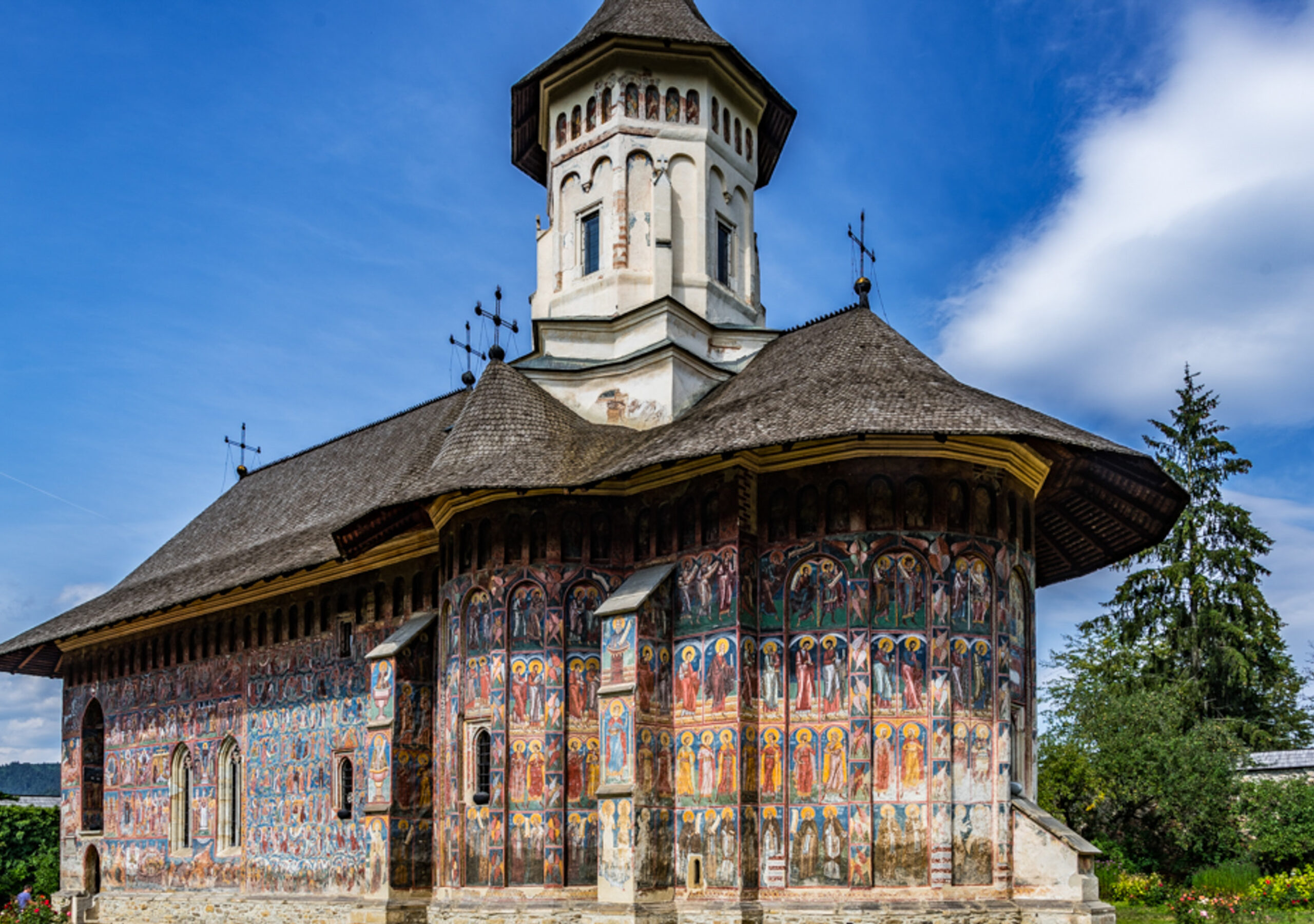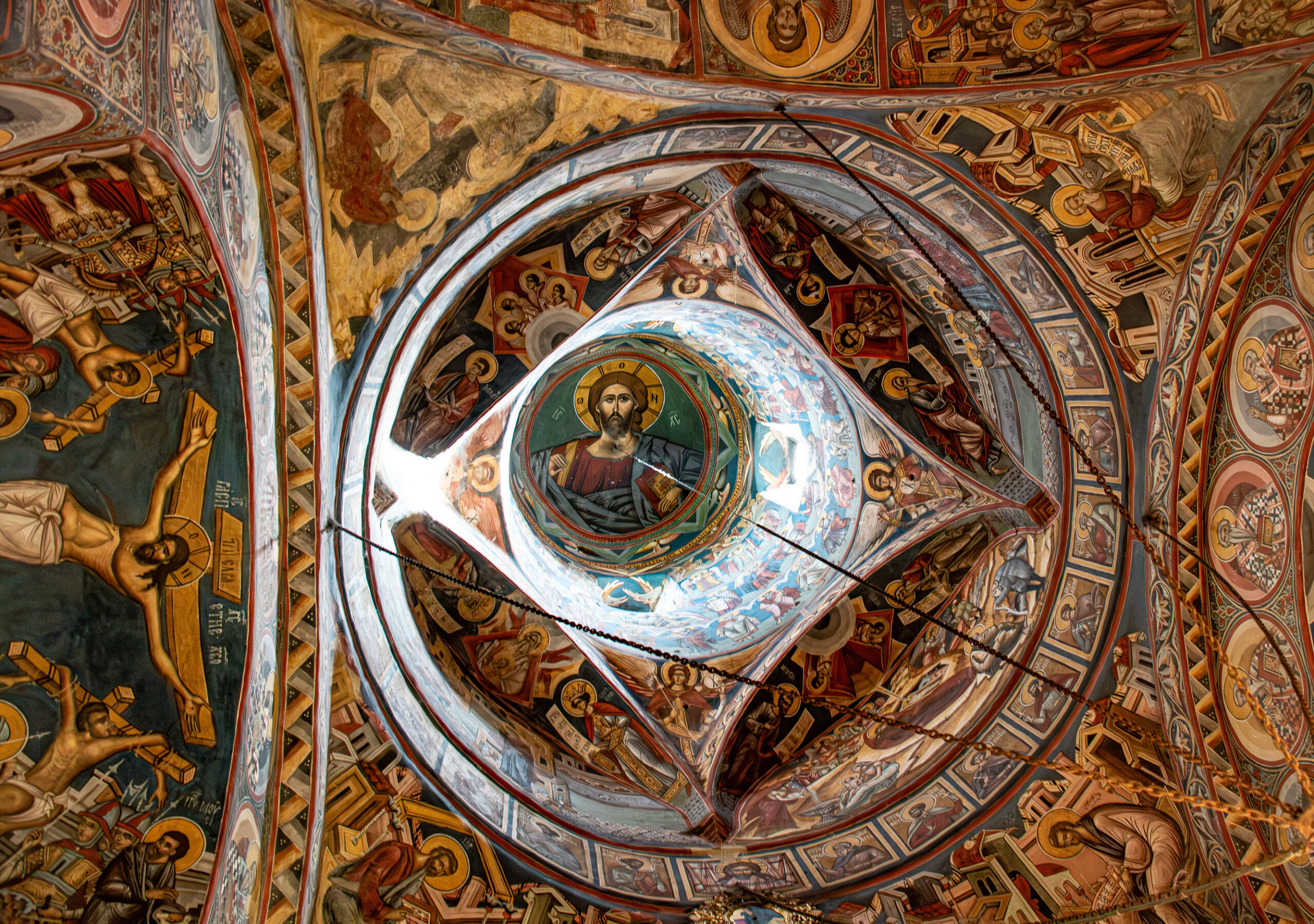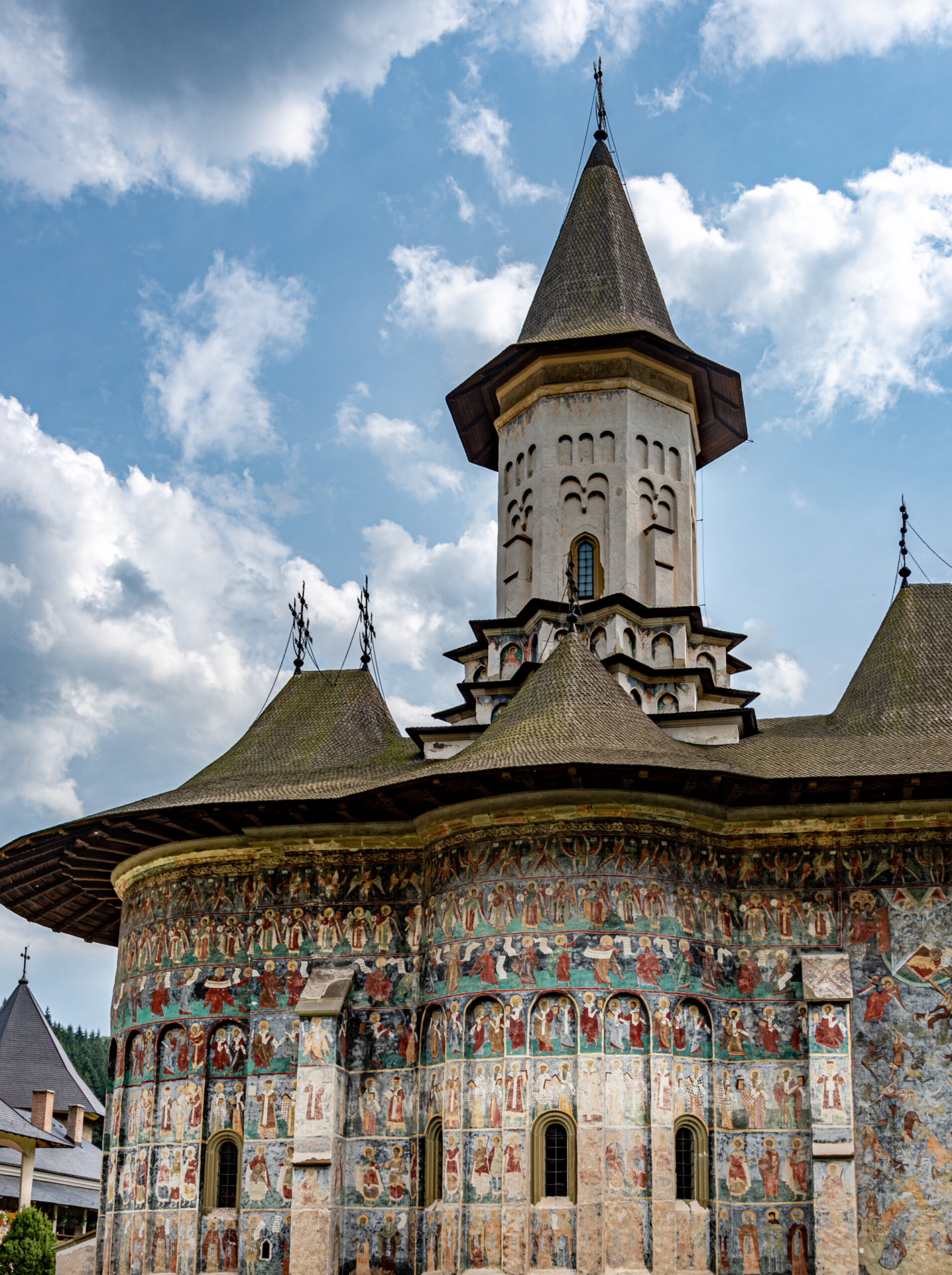Pictured above: A farming village nestles in the Carpathian Mountains
“Why travel to Romania?” you might ask. As a child, I fantasized about this mysterious country from watching Dracula and Frankenstein movies that took place in Transylvania, now part of Romania, in the far reaches of dark Eastern Europe. Ancient villages with thatched roofs, people dressed in black, horse-drawn carts, haystacks, pitchforks––you get the idea of what my imagination saw.
Rick and I spent a September in the Balkans, with Romania as a centerpiece. Compass Travel Romania assembled a fascinating ten-day guided tour, plus four days in Bulgaria. We wanted to explore this land of dramatic landscapes and the cultures of this continental crossroads of Europe and Asia that produced constant migration of conquerors and their conquered over millennia. Even today an uneasy détente among Muslims, Catholics, and Orthodox Christians persists in this region.
Romania exceeded my expectations, with its dramatic landscapes, bustling cities, quaint villages, medieval castles, its rustic country way of life, and its friendly, welcoming people. Every day dawned with new and unusual experiences, and the Painted Monasteries of Bucovina ranked high on the “OMG” list!
Let me take you back to this trip and the Painted Monasteries of Bucovina.
Bucovina, Romania—Home to the world’s great Byzantine art examples
As our late model rented Toyota crosses the magnificent Carpathian Mountains with knowledgeable guide Nic Zavada at the wheel, I feel silly saying “Wow!” again and again as each majestic landscape appears and vanishes around the road’s next treacherous S-curve. We climb from the fertile farming valley of the Maramures region over the pine tree-carpeted steep peaks of the range, my head swiveling like an Elvis Presley bobblehead on a dashboard, to take in the vistas. Small, picturesque mountain villages surrounded by farm plots dot the vast spaces.
Our destination––Bucovina, an area in the Slavic region of Moldova (not the country) in northeast Romania, with its different culture, architecture, and sometimes language from its western neighbors.
Bucovina is the home of eight fifteenth and sixteenth century UNESCO World Heritage Painted Monasteries, collectively considered one of the world’s great Byzantine art treasures. Richly colored graphic scenes of dramatic Biblical events and the holy men, angels, and demons who oversaw them decorate both their interior and exterior walls and ceilings. Priests intended these scenes, here and at all the monasteries, to scare the wits out of illiterate villagers, inspiring them to lead pious lives.
Apparently, nothing like them exists anywhere.
Arriving at Hotel La Conac on the outskirts of the town of Gura Humorului, crystal clear air with a hint of pine greets me as I step out of the car, prompting a deep breath to fill my lungs. After checking in, we’re off immediately to the first of three church complexes we’ll visit.
Voronet Monastery: the “Sistine Chapel of the East”
Built in 1487 by Stephen the Great to celebrate his victory over the Turks, the walled complex Voronet Monastery is the most famous, hailed as “the Sistine Chapel of the East” because of its elaborate and intricate paintings of sacred scenes, prayers, and Biblical episodes. Despite exposure to the elements, the exterior walls remain vivid, especially the blue paint. Commonly called Voronet Blue, craftsmen developed this enduring color in seclusion, and its secret formula died with them almost 600 years ago.
I gasp at the elaborate depiction of The Last Judgment that fills an entire outside wall. God sits at the top center weighing on a scale the recently deceased as they queue up for a “thumbs up or thumbs down” on their eternal fate. Will they be granted entry into the kingdom of heaven, which seems pleasant enough, with requisite angels fluttering about, rewards granted, and happy afterlives enjoyed eternally by all? Or will they be cast down into the depths of hell where everlasting suffering awaits? A river of fire separates the two worlds. In one disturbing underworld scene, beasts spit out the body parts of the castaways.
A Dark History Lies within Moldovita Monastery
Next stop––Moldovita Monastery, a 1532 creation, whose gold and blue colors dominate the Siege of Constantinople, which celebrates the Virgin Mary’s intercession to repel the Persian’s attack on the city. The Tree of Jesse, another full wall mural, presents the genealogy of Christ. Interior scenes capture my attention as well, especially detailed representations of gruesome torture and death. Apparently, infidels disposed of their captives, who all wear halos, by beheading, boiling, b urning, and flaying. Sad-eyed clerics line up underneath these death tableaus.
Here, and at the other two sites, nuns reside to help with daily upkeep and serve as tour guides if you speak Romanian. The women also tend beautiful gardens, especially beautiful with roses in bloom. Window sills support boxes with cascading flowers.
Sucevita Monastery is a Masterpiece in the High Byzantine Style
Our final church visit, Sucevita Monastery, distinguishes itself with high fortress walls, buttressed defense towers, and gothic windows in the church itself. This 1581 compound also served as a residence for the ruling prince of Moldavia. The last church to be decorated in this high Byzantine style, Sucevita marked an end of an era of creativity in medieval religious art, and art historians consider this church a masterpiece.
What catches my eye, though, is the incredibly detailed Ladder to Paradise or Ladder of Virtues that covers one wall. Supplicants seeking entrance to God’s kingdom climb a ladder, each rung representing a life quality upon which they are judged. Red-winged angels line the ladder to assist the climbers. At the top, an angel reaches out her hand to pull the successful petitioner through the pearly gates. At any rung, a supplicant could “slip” if he committed an unforgivable transgression in his life, tumbling––arms flailing in the greatest despair––into the flames below. Grinning horned demons pull the sinners down into the inferno. Apparently, there’s no second chance.
The region provides a lovely backdrop for these unexpected churches that exhibit an exquisite form of story-telling and artistry. Pretty villages and farms, horse-drawn carts of people and goods, local folks occasionally dressed in traditional, colorful clothing, and delicious food (order the sheep!) all make for an exuberant experience among the many exciting experiences Romania presents to travelers.
Postscript: Yes, I did visit Bram Castle in Transylvania––Dracula’s castle…so the legend goes.
If You Go
My best recommendation for visiting the Painted Monasteries of Bucovina is to make it part of a longer tour of Romania (I would recommend a week to ten days). The country is full of treasures to see!
Its cities are lively and historic, from capital city Bucharest to Sibiu, Cluj-Napoca, Brasov, Sighisoara, and Timisoara.
Travel Planning
We used Compass Travel Romania (tours-of-romania.com) for our terrific experience. Educated in the U.S., Andrei Miclea is founder and principal, and he promotes his company as a Romanian-American firm. Working with his folks was direct and easy. You’ll find trip prices very reasonable.
Romanianfriend.com An excellent site about the wonders and particulars about visiting Romania. Check it out.
Transportation
Romania is undiscovered on the traditional tourist route, so it’s not crowded. It’s much cheaper to travel here than in most other European countries.By Air––Many major airlines fly into Bucharest.
By Train––The capital is easily accessible by train internationally if you’re traveling from other Eastern European countries.
Getting around—Public transportation is not well developed. Buses and trains are effective for short distances, but to reach many interesting places, you need to travel by car. You can rent a car and drive yourself. However, roads aren’t always the best. (Frankly, we never noticed bad roads, but our guide Nicu Zavada knew the route.) I recommend hiring a guide and driver or joining a small group tour to make the most of getting around Romania.
Things to Do
Delightful regional area to visit include Maramures and Transylvania, in addition to Bucovina. Castles, Turda Salt Mines (really!), ancient citadels, Roma villages (inappropriately called gypsies) for which you’ll need a guide, other UNESCO World Heritage sites.
- Food
- When you’re in Bucharest, make a reservation at Caru cu Bere (carucubere.ro/en), “the soul of Bucharest,” a dramatic, atmospheric old-style restaurant with outside patio along the thoroughfare. Try the stuffed cabbage and bean casserole; the pork charcuterie was also delicious. Don’t forget to visit the inside of the restaurant. The carved wood and paneling, along with stained glass windows are breathtaking.

